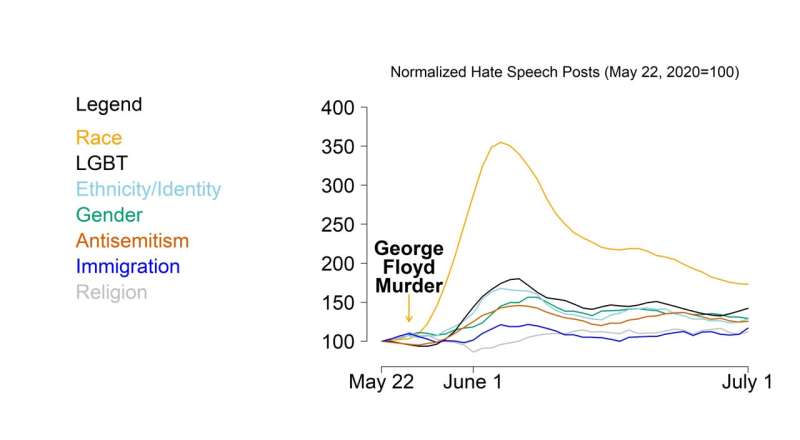This article has been reviewed according to Science X's editorial process and policies. Editors have highlighted the following attributes while ensuring the content's credibility:
fact-checked
peer-reviewed publication
trusted source
proofread
Tracking online hate speech that follows real-world events

A machine-learning analysis has revealed patterns in online hate speech that suggest complex—and sometimes counterintuitive—links between real-world events and different types of hate speech. Yonatan Lupu of George Washington University in Washington, D.C., and colleagues present these findings in the open-access journal PLOS ONE on January 25.
Prior research has uncovered key insights into hate speech posted publicly by users of online communities. Real-world events can trigger increases in online hate speech, and spikes in online hate speech have been linked to spikes in real-world violent hate crimes. However, most earlier studies have focused on a limited number of communities from moderated platforms that have policies against hate speech.
Lupu and colleagues combined manual methods with a computational strategy known as supervised machine learning to analyze seven kinds of online hate speech in 59 million posts published between June 2019 and December 2020 by users of 1,150 online hate communities. Some communities were on the moderated platforms Facebook, Instagram, or VKontakte, and others on the less-moderated platforms Gab, Telegram, and 4Chan.
This analysis revealed spikes in online hate speech rates that appeared associated with certain real-world events. For instance, after a crisis involving Syrian refugees, anti-immigration hate speech spiked significantly.
Following the November 2020 U.S. election, more sustained waves of increased online hate speech occurred. For example, there was an increase in the use of anti-LGBTQ slurs to describe various political targets, and Vice President Kamala Harris was a prominent target of increased gender-related hate speech.
Within the study period, the murder of George Floyd and subsequent protests were associated with the biggest spike in hate speech rates, including racially-based hate speech. However, other types of hate speech also spiked significantly, including hate speech targeting gender identity and sexual orientation—a topic with little intuitive connection to the murder and protests.
While the research cannot provide causal conclusions, the findings suggest a complex relationship between triggering events and online hate speech, with potential implications for strategies to mitigate such speech. The authors call for additional research to further examine this relationship, especially given users' tendency to migrate to unmoderated communities.
The authors add, "Hate speech continues to be a persistent and pervasive problem across the social media landscape, and can rise in dramatic and sometimes unexpected ways following offline events."
More information: Offline events and online hate, PLoS ONE (2023). DOI: 10.1371/journal.pone.0278511
Journal information: PLoS ONE
Provided by Public Library of Science



















